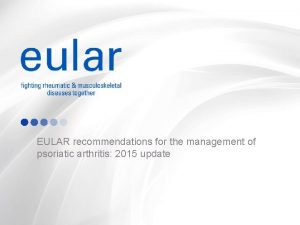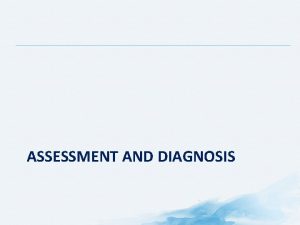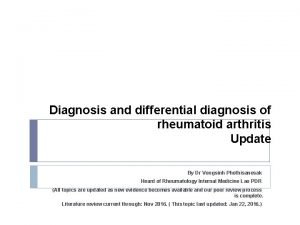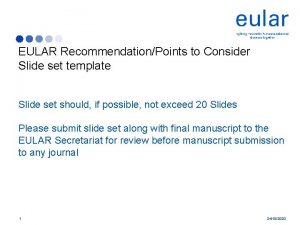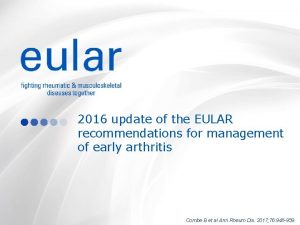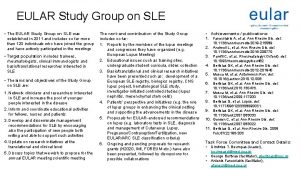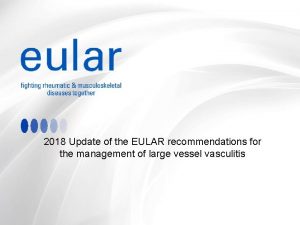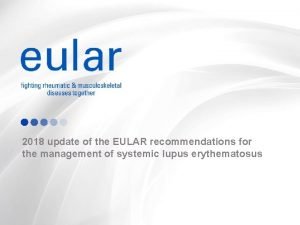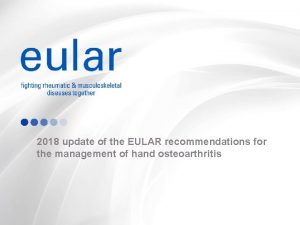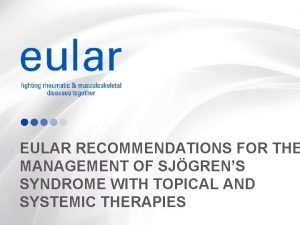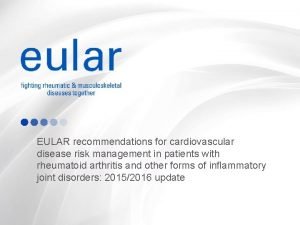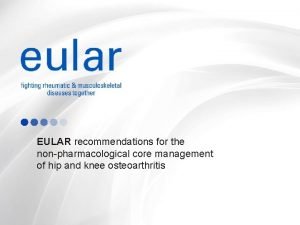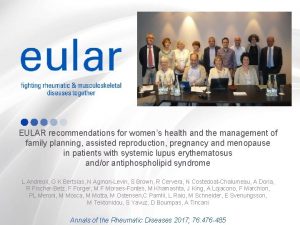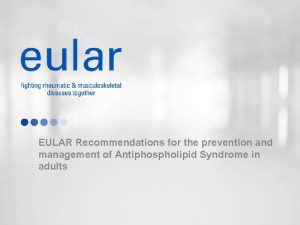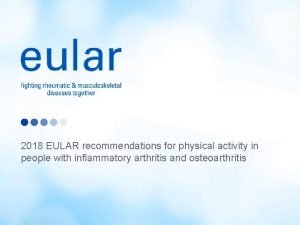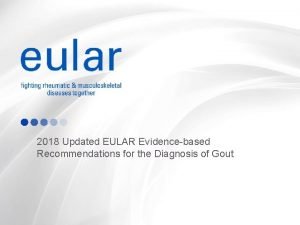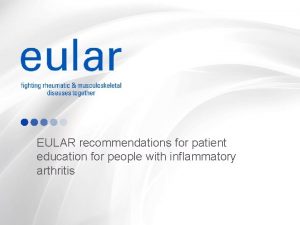2016 update of the EULAR recommendations for management


















- Slides: 18

2016 update of the EULAR recommendations for management of early arthritis Combe B et al Ann Rheum Dis. 2017; 76: 948 -959.

Target population/question Target population § Rheumatologists, § General practitioners, medical students, healthcare professionals, § Patients. Objective § To cover the entire spectrum of the management of early inflammatory arthritis: referral, diagnosis, prognosis, classification, information, education, pharmacological & non-pharmacological interventions, and monitoring. § The EULAR recommendations for management of early arthritis were published in 2007 and needed to be updated. 12/12/2021

Methods q In accordance with the 2014 EULAR SOP, the task force pursued an evidencebased approach and one based on expert opinion. q The expert committee defined the target population, formulated a definition of “management” and selected the research questions. q Based on these research questions, a SLR was performed by 2 fellows with the help of a skilled librarian. q For each recommendation, the categories of evidence were identified, the strength of recommendations was derived and the level of agreement was determined after an anonymized voting process. 12/12/2021

Overarching principles A Management of early arthritis should aim at the best care and must be based on a shared decision between the patient and the rheumatologist 9, 9* B Rheumatologists are the specialists who should primarily care for patients with early arthritis 9, 8 C A definitive diagnosis in a patient with early arthritis should only be made after a careful history taking and clinical examination which should also guide laboratory testing and additional procedures * level of agreement in the committee(0 -10) 1 9, 8 level of agreement in the committee(0 -10)

Recommendations Individual Recommendations 1 2 Patients presenting with arthritis (any joint swelling, associated with pain or stiffness) should be referred to, and seen by, a rheumatologist, within six weeks after the onset of symptoms. Clinical examination is the method of choice for detecting arthritis, which may be confirmed by ultrasonography

Recommendations Individual Recommendations 3 If a definite diagnosis cannot be reached and the patient has early undifferentiated arthritis, risk factors for persistent and/or erosive disease, including number of swollen joints, acute phase reactants, rheumatoid factor, ACPA and imaging, should be considered in management decisions. 4 Patients at risk of persistent arthritis should be started on DMARDs as early as possible (ideally within 3 months), even if they do not fulfill classification criteria for an inflammatory rheumatological disease.

Early arthritis Swollen joints, pain, stiffness History laboratory testing Clinical examination Definite arthritis Undifferentiated arthritis Risks factors Erosions, ACPA, RF, high disease activity YES Persistent and /or erosive arthritis NO Self-limiting arthritis Infection Reactive arthritis Other spondyloarthritis Connective tissue disease Polymyalgia rheumatica …

Recommendations Individual Recommendations 5 6 Among the DMARDs, methotrexate is considered to be the anchor drug and, unless contraindicated, should be part of the first treatment strategy in patients at risk of persistent disease. NSAIDs are effective symptomatic therapies, but should be used at the minimum effective dose for the shortest time possible, after evaluation of gastrointestinal, renal, and cardiovascular risks.

Recommendations Individual Recommendations 7 Systemic glucocorticoids reduce pain, swelling and structural progression, but in view of their cumulative side effects, they should be used at the lowest dose necessary as temporary (less than 6 months) adjunctive treatment. Intra-articular glucocorticoid injections should be considered for the relief of local symptoms of inflammation. 8 The main goal of DMARD treatment is to achieve clinical remission, and regular monitoring of disease activity, adverse events and comorbidities should guide decisions on choice and changes in treatment strategies to reach this target.

Recommendations Individual Recommendations 9 10 Monitoring of disease activity should include tender and swollen joint counts, patient’s and physician’s global assessments, ESR and CRP, usually by applying a composite measure. Arthritis activity should be assessed at one to three month intervals until the treatment target has been reached. Radiographic and patient reported outcome measures, such as functional assessments can be used to complement disease activity monitoring. Non-pharmacological interventions, such as dynamic exercises and occupational therapy, should be considered as adjuncts to drug treatment in patients with early arthritis.

Individual. Recommendations 11 12 In patients with early arthritis smoking cessation, dental care, weight control, assessment of vaccination status and management of comorbidities should be part of overall patient care. Patient information concerning the disease, its outcome (including comorbidities) and its treatment is important. Education programs aimed at coping with pain, disability, maintenance of ability to work and social participation may be used as adjunct interventions.

Early arthritis at risk of persistency/erosiveness No contra-indication for methotrexate Information Education NSAIDs Dynamic exercises Occupational therapy Prevention** e. g. : management of comorbidities Methotrexate with dose optimization +§ Short term low dose glucocorticoïds +§ Leflunomide or sulfasalazine or DMARDs combination Close monitoring of disease activity every 1 -3 months YES Achieve remission* within 6 months Continue § combination Contra-indication for methotrexate with glucocorticoïds preferred *Low disease activity could be an alternative target in rare occasions. ** should also include: weight loss, smoking cessation, dental care and vaccination DMARDs: Disease Modifying Anti-Rheumatic Drugs. NSAIDs : Non Steroidal Anti-inflammatory Drugs NO Adapt treatment strategy

Summary Table Oxford Level of Evidence Recommendation Lo. E* Go. R* Lo. A* 1. Early referral Ib B 9. 43 2. Clinical examination IIb C 9. 48 3. Prognosis IIb C 9. 83 4. Early treatment start Ia A 9. 35 5. MTX, the anchor drug Ia A 9. 52 6. NSAIDs IV D 9. 00 7. Glucocorticoids 8. Remission and treatment strategies Ia A 9. 00 Ib, IV A, D 9. 52 9. Regular monitoring 10. Non-pharmaceutical interventions Ia, IV A, D 9. 13 1 a B 8. 96 11. Prevention IIb, IV C, D$ 8. 96 Ia, Ib B 9. 35 12. Patient information * category of evidence; strenght of the recommendation; level of agreement in the committee(0 -10)

Summary of Recommendations 1. Patients presenting arthritis (any joint swelling, associated with pain or stiffness) should be referred to, and seen by, a rheumatologist, within six weeks after the onset of symptoms. 2. Clinical examination is the method of choice for detecting arthritis, which may be confirmed by ultrasonography. 3. If a definite diagnosis cannot be reached and the patient has early undifferentiated arthritis, risk factors for persistent and/or erosive disease, including number of swollen joints, acute phase reactants, rheumatoid factor, ACPA and imaging findings, should be considered in management decisions. 4. Patients at risk of persistent arthritis should be started on DMARDs as early as possible (ideally within 3 months), even if they do not fulfil classification criteria for an inflammatory rheumatologic disease. 5. Among the DMARDs, methotrexate is considered to be the anchor drug and, unless contraindicated, should be part of the first treatment strategy in patients at risk of persistent disease. 6. NSAIDs are effective symptomatic therapies but should be used at the minimum effective dose for the shortest time possible, after evaluation of gastrointestinal, renal, and cardiovascular risks. 12/12/2021

Summary of Recommendations 7. Systemic glucocorticoids reduce pain, swelling and structural progression, but in view of their cumulative side effects, they should be used at the lowest dose necessary as temporary (less than 6 months) adjunctive treatment. Intra-articular glucocorticoid injections should be considered for the relief of local symptoms of inflammation. 8. The main goal of DMARD treatment is to achieve clinical remission, and regular monitoring of disease activity, adverse events and comorbidities should guide decisions on choice and changes in treatment strategies to reach this target. 9. Monitoring of disease activity should include tender and swollen joint counts, patient and physician global assessments, ESR and CRP, usually by applying a composite measure. Arthritis activity should be assessed at one to three month intervals until the treatment target has been reached. Radiographic and patient-reported outcome measures, such as functional assessments, can be used to complement disease activity monitoring. 10. Non-pharmacological interventions, such as dynamic exercises and occupational therapy, should be considered as adjuncts to drug treatment in patients with early arthritis. 11. In patients with early arthritis smoking cessation, dental care, weight control, assessment of vaccination status and management of comorbidities should be part of overall patient care. 12. Patient information concerning the disease, its outcome (including comorbidities) and its treatment is important. Education programs aimed at coping with pain, disability, maintenance of ability to work and social participation may be used as adjunct interventions. 12/12/2021

Summary of Recommendations in lay format 1. People with any joint swelling causing pain or stiffness should be referred to, and seen by, a rheumatologist, within 6 weeks of their symptoms starting. 2. The preferred way to detect arthritis is for a rheumatologist to examine your joints. This may be confirmed with an ultrasound scan 3. If a definite diagnosis cannot be reached, risk factors should be considered in management decisions. 4. People at risk of persistent arthritis should be started on DMARDs as early as possible (ideally within 3 months), even if they do not fulfil the criteria for an inflammatory rheumatologic disease. 5. Methotrexate should be part of the first treatment strategy in people at risk of persistent disease. 6. NSAIDs should be used at the minimum effective dose for the shortest time possible, after evaluating your personal risks. * 12/12/2021

Summary of Recommendations in lay format 7. Steroids should be used at the lowest dose necessary as temporary treatment. Steroid injections into the joint should be considered for symptomatic relief 8. The main goal of DMARD treatment is to achieve clinical remission. Your disease activity, side effects and any other diseases you have will be monitored regularly to guide decisions about your treatment strategies in order to achieve the target of remission. 9. Monitoring should include counting how many tender or swollen joints you have. Your doctor may also use questionnaires, blood tests and X-rays. Arthritis activity should be assessed every 1– 3 months until your treatment target is reached. 10. As well as drug treatments, people with early arthritis should consider exercise and occupational therapy. 11. If you have early arthritis, part of your general care should include helping you to stop smoking and lose weight if you need to. Your doctor should also check your dental care and make sure you are up to date on all your vaccinations, as well as looking after any other diseases (comorbidities) that you might have. 12. It is important that you have information about your disease, its outcome (including comorbidities) and its treatment. You might be offered a place on an education programme to help you cope with pain and disability, and to maintain 12/12/2021

Acknowledgements Ø We thank the Expert Committee: 20 rheumatologists, 2 patients and 1 healthcare professional representing 12 European countries • Convenor & methodologist : B Combe, R Landewe • SLR: C Daien, C Hua • Members: D Aletaha, J M Alvaro Gracia , N Brodin, M Bakkers, D Shingle, G R Burmester, C Codreanu, R Conway, M Dougados, P Emery, G Ferraccioli, J Fonseca, K Raza, L Silva, J Smolen, , Z Szekanecz, T C Kvien, A van der Helm-van Mil, R van Vollenhoven Ø We also thank Louise Falzon, Columbia University Medical Centre (USA), expert librarian for her contribution in the SLR. 12/12/2021
 Gossec
Gossec Database backup and recovery techniques
Database backup and recovery techniques Eular graph
Eular graph Oa grade 2
Oa grade 2 Eular
Eular What is esr
What is esr Eular criteria for ra
Eular criteria for ra Eular
Eular Kontinuitetshantering
Kontinuitetshantering Typiska novell drag
Typiska novell drag Tack för att ni lyssnade bild
Tack för att ni lyssnade bild Returpilarna
Returpilarna Varför kallas perioden 1918-1939 för mellankrigstiden?
Varför kallas perioden 1918-1939 för mellankrigstiden? En lathund för arbete med kontinuitetshantering
En lathund för arbete med kontinuitetshantering Adressändring ideell förening
Adressändring ideell förening Tidbok yrkesförare
Tidbok yrkesförare Anatomi organ reproduksi
Anatomi organ reproduksi Förklara densitet för barn
Förklara densitet för barn Datorkunskap för nybörjare
Datorkunskap för nybörjare
